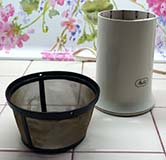While sipping your first cup of coffee in the morning, do you ever think about its environmental and social impact? I didn’t, but I do now.
While researching and writing about eco-friendly and ethical chocolate a few months ago, I learned that cacao and coffee growers often face similar issues like poverty and land degradation.
Everything we grow, make, and use has an environmental impact. This video provides a short overview of coffee’s environmental impact.
For those of us who are coffee drinkers, like my spouse and I, we can and should buy coffee from environmentally and socially responsible companies and look for ways to green our coffee drinking practices.
7 Ways to Green your Coffee Drinking
Purchase Eco-friendly Grown and Ethically Sourced Coffee
Some coffee brands focus more on environmental aspects of coffee growing and others on social responsibility. Fortunately, what is good for the land is usually good for the people who farm it. For instance, eliminating pesticides promotes healthy ecosystems and people. Intercropping coffee trees with other crops such as peppers, bananas, and avocados increases biodiversity and provides additional income for coffee farmers.
Bird-Friendly, Rainforest Alliance, and USDA Organic are a few certifications available for coffee that meets specific environmental and sometimes social requirements. Fairtrade and Fair Trade USA promote trade equity for coffee growers.
Brew your Own Coffee
 Brew coffee at home and skip the waste generated by take-out coffee—plastic lined, non-recyclable, non-compostable single-use cups, cardboard cup sleeves, plastic lids and stirrers, creamer and sugar packets, and paper napkins.
Brew coffee at home and skip the waste generated by take-out coffee—plastic lined, non-recyclable, non-compostable single-use cups, cardboard cup sleeves, plastic lids and stirrers, creamer and sugar packets, and paper napkins.
Give yourself extra credit if you brew with a reusable mesh filter basket instead of a paper filter.
Don’t use Bottled Water
Water is an important component of coffee taste. Don’t like the taste of your tap water? There are many easy and often inexpensive ways to filter water so just say no bottled water (forever).
Black is Best
Drinking coffee black is the most eco-friendly option. Stirring 1 tablespoon of cream into a cup of coffee increases its carbon footprint by 250% and adds 20 calories (sugar adds 49 calories). Although non-dairy creamers and artificial sweeteners may contain fewer calories, they are highly processed food-like substances so are not low carbon options. I am a non-dairy creamer user so need to work on this one.
 Thermoses are not just for Construction Workers
Thermoses are not just for Construction Workers
After the coffee is brewed instead of leaving the coffee maker warming plate on, pour the coffee in a thermos to keep it warm for future refills. Or brew with a coffee machine that uses a thermal carafe. A thermos is an easy and inexpensive way to take coffee to work.
Reusable Cups and Travel Mugs
 Whether at home, on the move, or at the office, use a reusable cup or travel mug. If you go to a coffeehouse and plan to hang out to drink your coffee, ask for a washable cup. Want your coffee to go? Patronize a coffeehouse that gives away or sells reusable travel mugs for customers to bring back for refills, or better yet, one that allows customers to bring their own reusable mugs and gives discounts to those who do.
Whether at home, on the move, or at the office, use a reusable cup or travel mug. If you go to a coffeehouse and plan to hang out to drink your coffee, ask for a washable cup. Want your coffee to go? Patronize a coffeehouse that gives away or sells reusable travel mugs for customers to bring back for refills, or better yet, one that allows customers to bring their own reusable mugs and gives discounts to those who do.
Compost Coffee Grounds
Collect and compost coffee grounds, and coffee filters if you use them. Don’t have a composter? Sprinkle coffee grounds around your garden—the plants will appreciate the nitrogen and their granular texture deters slimy insects.
Resources:
- Fairtrade International (FLO)
- Fair Trade USA
- Mayo Clinic – Coffee calories: Sabotaging your weight-loss goal?
- NRDC – Coffee, Conservation, and Commerce in the Western Hemisphere
- PBS – Your Coffee Dollar (try out this fun interactive page)
- Rainforest Alliance – Certification
- Smithsonian Migratory Bird Center – Bird Friendly®
- The Guardian – What’s the carbon footprint of … a cup of tea or coffee?
- USDA Organic
- Water Footprint Network – Product Water Footprints

I certainly had no idea how complicated and eco unfriendly the coffee industry is. If that video is a real description of what it takes to turn the coffee bean into drinkable coffee, then I am mighty glad that I have never partaken of coffee in any form (e.g. ice cream, candy, cookies, iced coffee, hot coffee). Of course, the world would be up in arms if they couldn’t have that morning coffee to get going. I personally prefer a hot shower and a glass of fresh orange juice.
A hot shower and glass of fresh orange juice sound like a good way to start the day.
your post was interesting. So you enjoy coffee without cream.
you said “1 tablespoon of cream into a cup of coffee increases its carbon footprint by 250%”. then do you have any idea that originally how much carbon footprints does that coffee cream has?
A cup of coffee with cream produces 53g CO2 (coffee 21g + cream 32g). The source is “The Guardian – What’s the carbon footprint of … a cup of tea or coffee?” (see resource section in post).